Simple Exercises to Keep Older Adults Moving – Part 3
By: John C. Griffin, MSc.
Functional mobility means being able to do the things we need to do in normal daily life efficiently and without undue fatigue or pain. Good functional mobility is part of a healthy, safe, and active life.
This is our third posting on functional mobility. In each posting, we offer you a screening test that helps you spot problems with functional mobility.
Then we show you how to use your findings to design exercises for yourself that will improve your functional mobility.
In this test, we focus on the upper body. This includes shoulder flexibility or ‘range of motion’. This is important for things like reaching up to a high shelf, combing your hair, putting on your clothes, reaching for something in the freezer, or reaching for a seat belt.
A warning before you start:
If you have significant or increasing pain with any test or exercise, you should stop right away. Get advice from a health care provider.
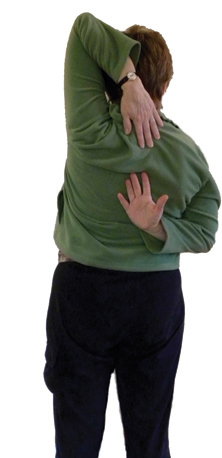
How to do the Back Scratch Test
- While standing, reach one arm up .
- Bend your elbow to pat your back.
- Reach your fingers down your back as far as you can.
- Put your other hand behind your back and reach your fingers up your back as far as you can.
- Try and touch your fingertips.
- Try again. If your fingers do not touch, guess how far apart your middle fingers are.
- Repeat, switching the position for each arm.
How did you do?
Score a “2” if you can touch your fingers.
Score a “1” if you are within 10cm (or 4 inches).
Score a “0” if you are more than 10cm (or 4 inches) OR if you have pain while doing it.
Score the test: Right arm upper ____ Left arm upper ____
‘Corner Wall Stretch’ — An exercise to improve your upper body flexibility
If you scored 0 or 1 in the Back Scratch Test, here is an exercise for shoulder flexibility. This exercise will improve your posture. It will also increase the range of motion in your shoulder. Improved flexibility decreases your chance of injury.
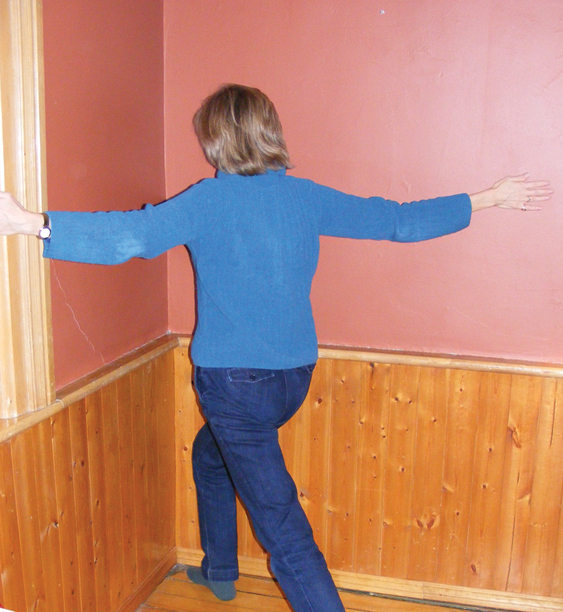
How to do “Corner Wall Stretch”
- Face into an open corner of a room.
- Place one foot into the corner with your hands flat against the walls and your elbows almost straight. Your arms are slightly below your shoulders.
- Lower your shoulder blades (scapulae) and pinch them together.
- Contract your abs (stomach muscles). Avoid arching your back.
- Slowly bend your leading leg and slightly lift your chest. Ease into the stretch in a slow and controlled way.
- When you can feel the stretch in your chest, hold the position for 12 – 15 seconds.
- Return to standing. Repeat 2-3 times.
About the author:
John C. Griffin, MSc., was a professor in the Fitness and Lifestyle Management Program at George Brown College in Toronto for 37 years. He is now a private consultant, speaker, coach, and writer for public and private sector organizations. John has authored more than 60 publications, numerous manuals, and a textbook published by Human Kinetics, Client-Centered Exercise Prescription. John is currently doing research on the functional mobility of adults 50-70 years of age.
Click Here for print PDF file -Active Living – Simple exercises to keep Older Adults Moving – Part 3
Simple exercises to keep Older Adults Moving – Part 2
By John C. Griffin, MSc.
Functional mobility means being able to do the things we need to do in normal daily life efficiently and without undue fatigue or pain. Good functional mobility is part of a healthy, safe, and active life.
This is our second posting on functional mobility. In each posting, we offer you a screening test that helps you identify problems with functional mobility. Then we show you how to use your findings to design exercises for yourself that will improve your functional mobility. (See Simple Exercises — Part 1)
In this test, we will focus on locomotor activities — how you move, how well you can change directions, and what your balance is like while moving. This is important for things like:
- walking on narrow or uneven surfaces
- quick turning or changes in direction
- walking and looking around
Caution: If you have significant pain or increasing pain with any test or exercise, you should stop and get advice from a health care provider.
How to do the Pivot & Walk Test
- Mark out a line 1 metre long on the floor with tape.
- Stand on one end of the line with your back to the line.
- Place one foot in front of the other.
- Line up the heel of one foot touching the toe of the other. You can choose which foot to put in front.
- Keep your arms down at your sides. Keep your head looking forward.
- Lift your heels to stand on your toes.
- In one smooth movement, turn halfway around to face the line, with your feet still in toe/heel position.
- Lower your heels and walk heel to toe along the marked line to the end.
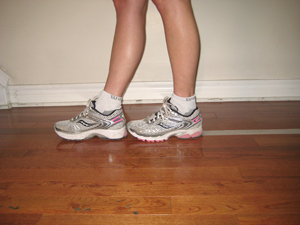
1-5
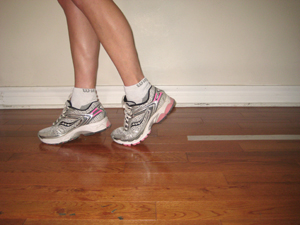
6
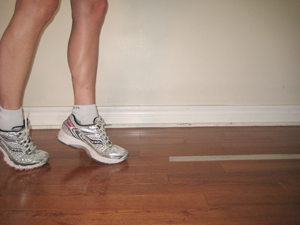
7

8
How did you do?
Score 2 if you were able to do all of these things:
- Turn smoothly.
- Keep your feet on the line after the turn.
- Walk the line staying very straight, with your feet on the line.
- Keep good balance.
Score 1 if you did any of these things:
- You had to pause on the turn.
- You were not on the line after you turned.
- You were not able to keep heel to toe (feet not on the line, or toes pointing off the line)
- You lost your balance a bit.
Score 0 if:
- You could not finish the test because you had too much trouble OR
- You had any pain while doing it.
“Fun Walks”: An exercise to improve your mobility
Now let’s focus on an exercise for the mobility needs that you may have if you scored 0 or 1 in the Pivot & Walk Test. This exercise will improve the strength, stability and balance needed for confident or more difficult walking.
How to do “Fun Walks”
- Place a chair in the middle of the floor.
- Walk around the chair on your toes. (You can touch the chair lightly if you need balance support.)
- Next time around, walk on your heels.
- Now change to the outside of your feet.
- Change again and walk around on the inside of your feet.
- Final time around, be a little creative or combine the various foot positions.
About the Author:
John C. Griffin, MSc., was a professor in the Fitness and Lifestyle Management Program at George Brown College in Toronto for 37 years. As a private consultant, speaker, coach, and writer for public and private sector organizations, John has authored more than 60 publications, numerous manuals, and a textbook published by Human Kinetics, Client-Centered Exercise Prescription. John is currently doing research on the functional mobility of adults 50-70 years of age.

- Categories
Recent Posts

